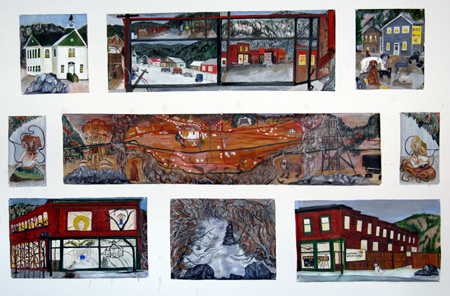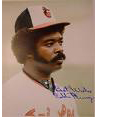
Painting
From Life vs.
From Photos
Arthur Whitman is an artist and critic writing for on-line and “real” newspapers. He was offered the opportunity to write professionally because of the high quality of the reviews he published on his blog, The Thinking Eye. I interviewed him recently via email. You can ask him questions here on Art & Perception.
Karl Zipser: What inspired you to start writing a blog?
Arthur Whitman: At least two things inspired me. First of all, my move in September 2005 from Boston to Ithaca. I felt isolated, both from the local artists community and from the larger artworld. To some extent I still do, but The Thinking Eye has helped me considerably on both fronts. The other thing was my interest in writing: for its own sake, as a way of understanding art better, and as a way of establishing a reputation as a writer.
Karl: How did the blog help establish your reputation as a writer?
Arthur: I’ve always been told that I write well, so I wanted to apply that skill somehow. Having studied studio art and art history in school, and being the kind of person who devours exhibits and art books, art writing seemed a natural choice. I lack the kind of “pedigree” that would easily get me a standard academic or journalistic job doing this. So one reason (although hardly the only one) that I started The Thinking Eye is show people what I could do. The Ithaca Times (the “alternative” weekly newspaper where I live”) agreed to let me do reviews for them without seeing a resume, so apparently my strategy works. I’ve only done two pieces for them so far, but hope to be writing for them more regularly in the coming months. Big Red and Shiny, a Boston online magazine has also printed one of my pieces. Another one will be coming in October.
Karl: Are you comfortable with being called an “art critic”?
Arthur: I’m increasingly comfortable being called an art critic, although I don’t consider all (or even most) of what I do on my blog criticism.
Karl: You art criticism writing can sometimes be harsh, no?
Arthur: While I do try to be as open-minded and thoughtful as possible (and I believe I’m pretty good at this), some of the art that I’ve written about just strikes me as wrongheaded on one or more levels. I feel my job as a critic is to be honest about this. People should be encouraged to make value judgments about artwork. Inevitably, other people’s judgments are going to be at least slightly different from my own.
Karl: Has your work as a critic changed you attitude about receiving criticism yourself?
Arthur: As for my own artwork, I’m confident that for all its flaws, what I do is complex and intelligent. So I think I would have a hard time taking a critic seriously if they dismissed it wholesale. Of course, that is probably the case for most artists.
Karl: You have studied many exhibitions. What in your opinion is the biggest mistake that an artist, gallery, or museum can make when installing a contemporary show?
Arthur: It depends on the interests and intentions of those involved: the artist, obviously, but also the curators and the audience. You could say that a failure to negotiate among these interests is the biggest mistake.
Karl: Are we living in a great moment in art history?
Arthur: My guess is that although we’re not in one of the greatest periods–such as the Renaissance or the early twentieth century–we’re hardly in the Dark Ages either. But I think we’ll have to wait a few generations to have really a clear idea about this. Today, everything from neo-classical and realistic painting to the most “far-out” conceptual art is being made and has its fans and partisans. I think the sheer diversity of work being made and discussed in the contemporary scene makes it difficult to get a consensus about the health of the artworld.
Karl: Do you see geographical location of art movements as an important factor in art today, as it was in the past?
Arthur: I think its considerably less important than in the past. With the existence and prevalence of the Internet, cheap high-quality reproductions, art magazines, plane travel, huge museums and so forth, we live in a much smaller world than we did even 50 years ago. That said, I do think that visual art generally has a local character. For example, there are lot of artists that you see commonly in European museums that are very difficult to find here in the United States. There are a lot of artists that you can see in New York City that are unlikely to show up here in Ithaca, which is only a six hour drive away (and vice versa). I think that in an era of globalized popular culture, that this local character is worth preserving.
Karl: Do you think the internet harms the development of local art culture?
Arthur: I don’t think of the Internet as having a devastating effect on local art, although I’m sure its possible. When I said that I valued local cultures, I didn’t mean that cities or towns or regions should isolate themselves from the rest of the world. On the contrary, I believe that artists and other serious art fans should travel as widely as possible to see art. The Internet is simply another way of spreading information and opinions about art from all over. I have difficulty seeing that as anything other than positive. Living in a small town, one of my own goals as a writer has been to challenge the provincialism and poverty of influence that I believe prevents many local artists from reaching their potential.
Local art cultures (and local cultures in general) are important because they provide an alternative to the world of mass media, mass culture, and mass production. These systems tend to level out the differences between different places. People around the world can (and do) watch the same movies and TV shows, wear the same clothes, even read the same books. With art, the object is usually either one of a kind or exists as a limited number of copies (as with printmaking, art photography and some kinds of sculpture). So, despite efforts to send these objects around the world, art tends to “stick” to specific areas.
Balancing the local quality of art with the “global village” of the Internet is a challenge, but I am optimistic that good things will come of it.
Karl: Thanks for your time, Arthur. Would you take questions from readers?
Arthur: Yes.


 When I was growing up, I was led to believe that the first baseman for the Baltimore Orioles, Eddie Murray, was a jerk. Not a fan of the Orioles, I had no reason to disagree. Later, I learned why I had been told this: he didn’t like talking to the Media. And who told me this? The Media.
When I was growing up, I was led to believe that the first baseman for the Baltimore Orioles, Eddie Murray, was a jerk. Not a fan of the Orioles, I had no reason to disagree. Later, I learned why I had been told this: he didn’t like talking to the Media. And who told me this? The Media.